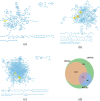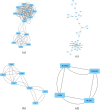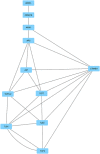Circadian clock crosstalks with autism
- PMID: 37807632
- PMCID: PMC10726833
- DOI: 10.1002/brb3.3273
Circadian clock crosstalks with autism
Abstract
Background: The mechanism underlying autism spectrum disorder (ASD) remains incompletely understood, but researchers have identified over a thousand genes involved in complex interactions within the brain, nervous, and immune systems, particularly during the mechanism of brain development. Various contributory environmental effects including circadian rhythm have also been studied in ASD. Thus, capturing the global picture of the ASD-clock network in combined form is critical.
Methods: We reconstructed the protein-protein interaction network of ASD and circadian rhythm to understand the connection between autism and the circadian clock. A graph theoretical study is undertaken to evaluate whether the network attributes are biologically realistic. The gene ontology enrichment analyses provide information about the most important biological processes.
Results: This study takes a fresh look at metabolic mechanisms and the identification of potential key proteins/pathways (ribosome biogenesis, oxidative stress, insulin/IGF pathway, Wnt pathway, and mTOR pathway), as well as the effects of specific conditions (such as maternal stress or disruption of circadian rhythm) on the development of ASD due to environmental factors.
Conclusion: Understanding the relationship between circadian rhythm and ASD provides insight into the involvement of these essential pathways in the pathogenesis/etiology of ASD, as well as potential early intervention options and chronotherapeutic strategies for treating or preventing the neurodevelopmental disorder.
Keywords: ASD; bioinformatics; circadian rhythmicity; neurodevelopmental diseases; protein-protein interaction network.
© 2023 The Authors. Brain and Behavior published by Wiley Periodicals LLC.
Figures






Similar articles
-
The influence of circadian rhythms and aerobic glycolysis in autism spectrum disorder.Transl Psychiatry. 2020 Nov 16;10(1):400. doi: 10.1038/s41398-020-01086-9. Transl Psychiatry. 2020. PMID: 33199680 Free PMC article. Review.
-
Disruption of circadian rhythm and risk of autism spectrum disorder: role of immune-inflammatory, oxidative stress, metabolic and neurotransmitter pathways.Rev Neurosci. 2021 May 28;33(1):93-109. doi: 10.1515/revneuro-2021-0022. Print 2022 Jan 27. Rev Neurosci. 2021. PMID: 34047147
-
Are circadian rhythms new pathways to understand Autism Spectrum Disorder?J Physiol Paris. 2016 Nov;110(4 Pt B):434-438. doi: 10.1016/j.jphysparis.2017.06.002. Epub 2017 Jun 20. J Physiol Paris. 2016. PMID: 28625682 Review.
-
Melatonin and Circadian Rhythm in Autism Spectrum Disorders.Turk Psikiyatri Derg. 2020 Fall;31(3):201-211. doi: 10.5080/u25160. Turk Psikiyatri Derg. 2020. PMID: 32978956 Review. English, Turkish.
-
Melatonin as a Novel Interventional Candidate for Fragile X Syndrome with Autism Spectrum Disorder in Humans.Int J Mol Sci. 2017 Jun 20;18(6):1314. doi: 10.3390/ijms18061314. Int J Mol Sci. 2017. PMID: 28632163 Free PMC article. Review.
Cited by
-
A Comprehensive Systematic Review Coupled with an Interacting Network Analysis Identified Candidate Genes and Biological Pathways Related to Bovine Temperament.Genes (Basel). 2024 Jul 25;15(8):981. doi: 10.3390/genes15080981. Genes (Basel). 2024. PMID: 39202342 Free PMC article.
-
Genetic and Environmental Factors Co-Contributing to Behavioral Abnormalities in adnp/adnp2 Mutant Zebrafish.Int J Mol Sci. 2024 Aug 30;25(17):9469. doi: 10.3390/ijms25179469. Int J Mol Sci. 2024. PMID: 39273418 Free PMC article.
References
-
- Abdul, F. , Sreenivas, N. , Kommu, J. V. S. , Banerjee, M. , Berk, M. , Maes, M. , Leboyer, M. , & Debnath, M. (2022). Disruption of circadian rhythm and risk of autism spectrum disorder: Role of immune‐inflammatory, oxidative stress, metabolic and neurotransmitter pathways. Reviews in the Neurosciences, 33(1), 93–109. 10.1515/revneuro-2021-0022 - DOI - PubMed
-
- Aken, B. L. , Ayling, S. , Barrell, D. , Clarke, L. , Curwen, V. , Fairley, S. , Fernandez Banet, J. , Billis, K. , García Girón, C. , Hourlier, T. , Howe, K. , Kähäri, A. , Kokocinski, F. , Martin, F. J. , Murphy, D. N. , Nag, R. , Ruffier, M. , Schuster, M. , Tang, Y. A. , … Searle, S. M. J. (2016). The Ensembl gene annotation system. Database, 2016, baw093. 10.1093/database/baw093 - DOI - PMC - PubMed
-
- Alkelai, A. , Greenbaum, L. , Lupoli, S. , Kohn, Y. , Sarner‐Kanyas, K. , Ben‐Asher, E. , Lancet, D. , Macciardi, F. , & Lerer, B. (2012). Association of the type 2 diabetes mellitus susceptibility gene, TCF7L2, with schizophrenia in an Arab‐Israeli family sample. PLoS ONE, 7(1), e29228. 10.1371/journal.pone.0029228 - DOI - PMC - PubMed
-
- Allotey, J. , Zamora, J. , Cheong‐See, F. , Kalidindi, M. , Arroyo‐Manzano, D. , Asztalos, E. , Van Der Post, J. A. M. , Mol, B. W. , Moore, D. , & Birtles, D. (2018). Cognitive, motor, behavioural and academic performances of children born preterm: A meta‐analysis and systematic review involving 64 061 children. BJOG: An International Journal of Obstetrics & Gynaecology, 125(1), 16–25. - PubMed
Publication types
MeSH terms
Grants and funding
LinkOut - more resources
Full Text Sources
Medical
Miscellaneous

